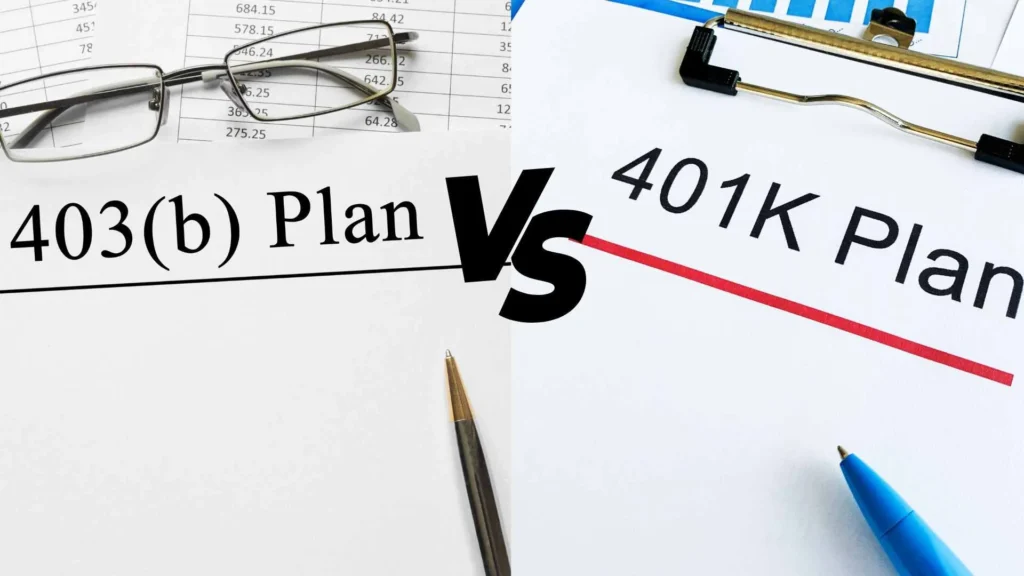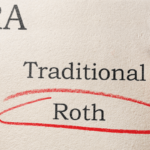Understanding the difference between a 403(b) and 401(k) plan is vital for a financially secure retirement. Here is a concise summary of all the key points between the two plans!
In this article, you find:
- Overview of a 403(b) Plan
- Overview of a 401(k) Plan
- What’s the difference between a 403(b) and a 401(k)?
- Should I choose a 403(b) or a 401(k)?

Overview of a 403(b) Plan
A 403(b) plan is commonly associated with public schools, universities, and non-profit organizations. This retirement savings vehicle allows employees to contribute pre-tax dollars from their salaries, effectively reducing their taxable income. Historically, 403(b) plans were limited to offerings such as mutual funds and annuities. However, modern plans may provide a broader range of investment options, including exchange-traded funds (ETFs) and target-date funds.
One significant advantage of a 403(b) plan is the availability of catch-up contributions for individuals nearing retirement age. These additional contributions allow teachers to accelerate their savings in the years leading up to retirement. Furthermore, contributions to a 403(b) plan grow tax-deferred, meaning that investment earnings are not subject to taxes until withdrawals are made during retirement. However, withdrawals from a 403(b) plan are taxed as ordinary income, which is an important consideration for retirees.
Overview of a 401(k) Plan
In contrast, a 401(k) plan is typically offered by for-profit companies to their employees. Like the 403(b) plan, contributions to a 401(k) plan are made with pre-tax dollars, resulting in immediate tax savings for participants. However, one key distinction is the broader range of investment options available within a 401(k) plan. While both plans may offer mutual funds and annuities, 401(k) plans often include additional options such as individual stocks, bonds, and real estate investment trusts (REITs).
Similar to the 403(b) plan, individuals enrolled in a 401(k) plan may take advantage of catch-up contributions as they approach retirement age. Additionally, contributions to a 401(k) plan grow tax-deferred, providing the opportunity for compound growth over time. However, like withdrawals from a 403(b) plan, distributions from a 401(k) plan are taxed as ordinary income, potentially impacting retirees’ tax liabilities.
What’s the difference between a 403(b) and a 401(k)?
While both 403(b) and 401(k) plans offer tax-advantaged retirement savings, there are notable differences between the two. The primary distinction lies in the types of organizations that offer these plans. 403(b) plans are commonly associated with non-profit entities, including public schools and universities, while 401(k) plans are prevalent in the for-profit sector.
Another significant difference is the investment options available within each plan. While both plans may offer traditional investment vehicles such as mutual funds and annuities, 401(k) plans often provide a wider selection of investment choices. This diversity can be advantageous for individuals seeking to customize their investment portfolios to align with their financial goals and risk tolerance.
Additionally, 401(k) plans may offer loan options, allowing participants to borrow against their retirement savings under certain circumstances. While this feature can provide financial flexibility, it’s essential to consider the potential long-term implications of borrowing from your retirement account, including repayment terms and the impact on future retirement income.

Should I choose a 403(b) or a 401(k)?
Deciding between a 403(b) and 401(k) plan requires careful consideration of various factors, including individual preferences, employer offerings, and long-term financial objectives. For teachers, in particular, maximizing retirement savings is crucial, given the importance of securing financial stability during retirement years.
When evaluating retirement plan options, educators should assess the investment choices available within each plan, considering factors such as expense ratios, historical performance, and diversification strategies. Additionally, individuals nearing retirement age may prioritize catch-up contributions to accelerate savings growth in preparation for retirement.
Furthermore, it’s essential to explore whether your employer offers a matching contribution incentive for either plan. Employer matching contributions can significantly enhance retirement savings by providing additional funds based on employee contributions. Understanding the terms and conditions of employer matching contributions can inform your decision-making process and maximize the benefits of your chosen retirement plan.
Special Considerations for Teachers
As educators, teachers face unique challenges and opportunities when planning for retirement. While 403(b) plans are prevalent in the education sector, some teachers may have access to 401(k) plans through private educational institutions or alternative employment arrangements.
When assessing 403(b) options, teachers should be aware of potential limitations compared to 401(k) plans, particularly regarding investment choices and administrative fees. Some 403(b) plans may have restrictions on the types of investments available or impose higher fees, which can impact long-term investment returns.
Additionally, educators should prioritize maximizing contributions to their retirement plans and seek professional guidance to develop a comprehensive retirement strategy. Consulting with a qualified financial advisor can help teachers navigate complex retirement decisions, optimize savings opportunities, and mitigate potential risks.
Conclusion
Navigating retirement savings as a teacher requires careful consideration of various factors, including the differences between 403(b) and 401(k) plans. While both retirement vehicles offer tax-advantaged savings opportunities, understanding the nuances of each plan is essential for making informed decisions about your financial future.
Whether you’re enrolled in a 403(b) plan through a public school or considering alternative retirement options, maximizing contributions, evaluating investment choices, and seeking professional guidance are critical steps toward achieving long-term financial security. By taking proactive steps to plan for retirement, educators can enjoy a fulfilling and financially secure post-career life.
Disclaimer: The information provided in this article is for educational purposes only and should not be construed as financial advice. Individuals should consult with a qualified financial advisor to discuss their specific retirement goals and circumstances.
Similar Read:





